A Field Investigation of Stability Characteristics of Pressure Fluctuation and Vibration in Prototype Pump Turbine at Multiple Working Points
Abstract
:1. Introduction
2. Experimental Methods and Data Acquisition
2.1. Experimental Design of Working Points
2.2. Experimental Equipment and Installation
2.3. Data Acquisition Configuration
3. Results and Discussion
3.1. Turbine Mode
3.1.1. Pressure Fluctuation in Turbine Mode
3.1.2. Vibration Acceleration in Turbine Mode
3.2. Pump Mode
3.2.1. Pressure Fluctuation in Pump Mode
3.2.2. Vibration Acceleration in Pump Mode
4. Conclusions
Author Contributions
Funding
Data Availability Statement
Acknowledgments
Conflicts of Interest
References
- China Renewable Energy Engineering Institute. China Renewable Energy Development Report 2022. 2023. Available online: http://www.creei.cn/web/content.html?id=5429 (accessed on 17 September 2023).
- Zhao, X.X.; Ren, Y.; Sha, Y.B.; Zhang, L.L.; Hou, S.C.; Xiao, F.M.; Chen, F.M.; Chen, S.D.; He, K.D.; Luo, L.J.; et al. Research on the Impact of Hydro-PV Complementary System Operation on Power Grid Based on New Energy Consumption. Math. Probl. Eng. 2022, 2022, 8459948. [Google Scholar] [CrossRef]
- Guerra, K.; Haro, P.; Gutierrez, R.E.; Gomez-Barea, A.A. Facing the high share of variable renewable energy in the power system: Flexibility and stability requirements. Appl. Energy 2022, 310, 118561. [Google Scholar] [CrossRef]
- Morabito, A.; Hendrick, P. Pump as turbine applied to micro energy storage and smart water grids: A case study. Appl. Energy 2019, 241, 567–579. [Google Scholar] [CrossRef]
- Heard, B.P.; Brook, B.W.; Wigley, T.M.L.; Bradshaw, C.J.A. Burden of proof: A comprehensive review of the feasibility of 100% renewable-electricity systems. Renew. Sustain. Energy Rev. 2017, 76, 1122–1133. [Google Scholar] [CrossRef]
- Zuo, Z.G.; Liu, S.H. Flow-Induced Instabilities in Pump-Turbines in China. Engineering 2017, 3, 504–511. [Google Scholar] [CrossRef]
- Asomani, S.N.; Yuan, J.P.; Wang, L.Y.; Appiah, D.; Zhang, F. Geometrical effects on performance and inner flow characteristics of a pump-as-turbine: A review. Adv. Mech. Eng. 2020, 12, 1687814020912149. [Google Scholar] [CrossRef]
- Egusquiza, E.; Valero, C.; Huang, X.X.; Jou, E.; Guardo, A.; Rodriguez, C. Failure investigation of a large pump-turbine runner. Eng. Fail Anal. 2012, 23, 27–34. [Google Scholar] [CrossRef]
- Yu, A.; Wang, Y.S.; Tang, Q.H.; Lv, R.R.; Yang, Z.P. Investigation of the vortex evolution and hydraulic excitation in a pump-turbine operating at different conditions. Renew. Energy 2021, 171, 462–478. [Google Scholar] [CrossRef]
- Li, L.; Tan, D.; Yin, Z.; Wang, T.; Fan, X.; Wang, R. Investigation on the multiphase vortex and its fluid-solid vibration characters for sustainability production. Renew. Energy 2021, 175, 887–909. [Google Scholar] [CrossRef]
- Li, L.; Xu, W.X.; Tan, Y.F.; Yang, Y.S.; Yang, J.G.; Tan, D.P. Fluid-induced vibration evolution mechanism of multiphase free sink vortex and the multi-source vibration sensing method. Mech. Syst. Signal Proces. 2023, 189, 110058. [Google Scholar] [CrossRef]
- Kim, S.J.; Suh, J.W.; Yang, H.M.; Park, J.; Kim, J.H. Internal flow phenomena of a Pump-Turbine model in turbine mode with different Thoma numbers. Renew. Energy 2022, 184, 510–525. [Google Scholar] [CrossRef]
- Lin, T.; Li, J.; Xie, B.F.; Zhang, J.R.; Zhu, Z.C.; Yang, H.; Wen, X.M. Vortex-Pressure Fluctuation Interaction in the Outlet Duct of Centrifugal Pump as Turbines (PATs). Sustainability 2022, 14, 15250. [Google Scholar] [CrossRef]
- Xia, L.S.; Cheng, Y.G.; Yang, J.D.; Cai, F. Evolution of flow structures and pressure fluctuations in the S-shaped region of a pump-turbine. J. Hydraul. Res. 2019, 57, 107–121. [Google Scholar] [CrossRef]
- Pang, S.J.; Zhu, B.S.; Shen, Y.D.; Chen, Z.M. S-shaped characteristics of pump turbine with large guide vane opening by experimental and numerical analysis. AIP Adv. 2023, 13, 015201. [Google Scholar] [CrossRef]
- Gentner, C.; Sallaberger, M.; Widmer, C.; Bobach, B.J.; Jaberg, H.; Schiffer, J.; Senn, F.; Guggenberger, M. Comprehensive experimental and numerical analysis of instability phenomena in pump turbines. In Proceedings of the 27th Iahr Symposium on Hydraulic Machinery and Systems (Iahr 2014), Montreal, QC, Canada, 22–26 September 2014; Volume 22. [Google Scholar] [CrossRef]
- Zhang, W.W.; Chen, Z.M.; Zhu, B.S.; Zhang, F. Pressure fluctuation and flow instability in S-shaped region of a reversible pump-turbine. Renew. Energy 2020, 154, 826–840. [Google Scholar] [CrossRef]
- Deniz, S.; Asaro, F. Improvements of Flow Control with Fluid Injection for the Suppression of Flow Instabilities in Pump-Turbines. In Proceedings of the Asme 2021 Fluids Engineering Division Summer Meeting (Fedsm 2021), Virtual, 10–12 August 2021; Volume 2. [Google Scholar]
- Liu, J.T.; Wu, Y.L.; Wang, L.Q. Instability Analysis of a Model Pump-Turbine with MGV Based on Nonlinear Partially Averaged Navier-Stokes Methods. Adv. Mech. Eng. 2013, 5, 710769. [Google Scholar] [CrossRef]
- Chen, H.; Lu, Y.; Liu, K.; Zhang, Z.; Li, H.; Huang, X.; Zhao, W.; Wang, Z. Study on the Internal Flow Characteristics of Long and Short Blade Runners of a 1000 MW Francis Turbine under Different Opening Conditions. Processes 2023, 11, 1796. [Google Scholar] [CrossRef]
- Hu, J.H.; Yang, J.B.; He, X.H.; Zeng, W.; Zhao, Z.G.; Yang, J.D. Transition of amplitude-frequency characteristic in rotor-stator interaction of a pump-turbine with splitter blades. Renew. Energy 2023, 205, 663–677. [Google Scholar] [CrossRef]
- Song, H.Q.; Zhang, J.F.; Huang, P.; Cai, H.K.; Cao, P.Y.; Hu, B. Analysis of Rotor-Stator Interaction of a Pump-Turbine with Splitter Blades in a Pump Mode. Mathematics 2020, 8, 1465. [Google Scholar] [CrossRef]
- Qin, Y.L.; Li, D.Y.; Zhu, Y.T.; Wang, H.J.; Wei, X.Z. Influence of geometric factors at runner outlet on the hump characteristics of a pump-turbine. Sustain. Energy Technol. Assess. 2022, 51, 101890. [Google Scholar] [CrossRef]
- Yang, G.; Shen, X.; Shi, L.; Meng, J.; Luo, W.; Zhang, D.; van Esch, B.P.M. Unsteady numerical investigations of the effect of guide vane openings on the hydrodynamic characteristics under stall conditions in a pump-turbine pump mode. Energy Convers. Manag. 2023, 293, 117499. [Google Scholar] [CrossRef]
- Barrio, R.; Fernandez, J.; Blanco, E.; Parrondo, J.; Marcos, A. Performance characteristics and internal flow patterns in a reverse-running pump-turbine. Proc. Inst. Mech. Eng. Part C J. Mech. Eng. Sci. 2012, 226, 695–708. [Google Scholar] [CrossRef]
- Valentin, D.; Presas, A.; Bossio, M.; Egusquiza, M.; Egusquiza, E.; Valero, C. Feasibility of Detecting Natural Frequencies of Hydraulic Turbines While in Operation, Using Strain Gauges. Sensors 2018, 18, 174. [Google Scholar] [CrossRef] [PubMed]
- Valentin, D.; Presas, A.; Valero, C.; Egusquiza, M.; Egusquiza, E. Detection of Hydraulic Phenomena in Francis Turbines with Different Sensors. Sensors 2019, 19, 4053. [Google Scholar] [CrossRef]
- Hu, J.H.; Yang, J.B.; Zeng, W.; Zhao, Z.G.; Yang, J.D. Hydraulic interaction of two parallel pump-turbines in constant-speed oscillation: Measurement, simulation, and sensitivity analysis. Renew. Energy 2021, 176, 269–279. [Google Scholar] [CrossRef]
- Zhang, Y.N.; Chen, T.; Li, J.W.; Yu, J.X. Experimental Study of Load Variations on Pressure Fluctuations in a Prototype Reversible Pump Turbine in Generating Mode. J. Fluid Eng. 2017, 139, 074501. [Google Scholar] [CrossRef]
- Hu, J.H.; Yang, J.D.; Zeng, W.; Yang, J.B. Transient Pressure Analysis of a Prototype Pump Turbine: Field Tests and Simulation. J. Fluid Eng. 2018, 140, 071102. [Google Scholar] [CrossRef]
- Zhang, F.; Lowys, P.Y.; Houdeline, J.B.; Guo, X.D.; Hong, P.; Laurant, Y. Pump-turbine Rotor-Stator Interaction Induced Vibration: Problem Resolution and Experience. In Proceedings of the 30th Iahr Symposium on Hydraulic Machinery and Systems (Iahr 2020), Lausanne, Switzerland, 21–26 March 2021; Volume 774. [Google Scholar] [CrossRef]
- Kim, S.J.; Suh, J.W.; Choi, Y.S.; Park, J.; Park, N.H.; Kim, J.H. Inter-Blade Vortex and Vortex Rope Characteristics of a Pump-Turbine in Turbine Mode under Low Flow Rate Conditions. Water 2019, 11, 2554. [Google Scholar] [CrossRef]
- Zhang, Y.N.; Zhang, Y.N.; Wu, Y.L. A review of rotating stall in reversible pump turbine. Proc. Inst. Mech. Eng. Part C J. Mech. Eng. Sci. 2017, 231, 1181–1204. [Google Scholar] [CrossRef]
- Hu, H.P.; Xia, M.; Qiao, M.; Wang, W.; Wang, J.Z.; Wang, Z.W. A Simulation Study of Hydraulic Vibration caused by Clearance Flow in a Pump Turbine. IOP Conf. Ser. Earth Environ. Sci. 2022, 1079, 012032. [Google Scholar] [CrossRef]
- Zheng, X.; Zhang, S.; Zhang, Y.; Li, J.; Zhang, Y. Dynamic characteristic analysis of pressure pulsations of a pump turbine in turbine mode utilizing variational mode decomposition combined with Hilbert transform. Energy 2023, 280, 128148. [Google Scholar] [CrossRef]
- Doerfler, P. On the role of phase resonance in vibrations caused by blade passage in radial hydraulic turbomachines. IAHRSection Hydraulic Machinery, Equipment, and Cavitation. In Proceedings of the 12th IAHR Symposium on Hydraulic Machineryand System, Stirling, UK, 27–30 August 1984. [Google Scholar]
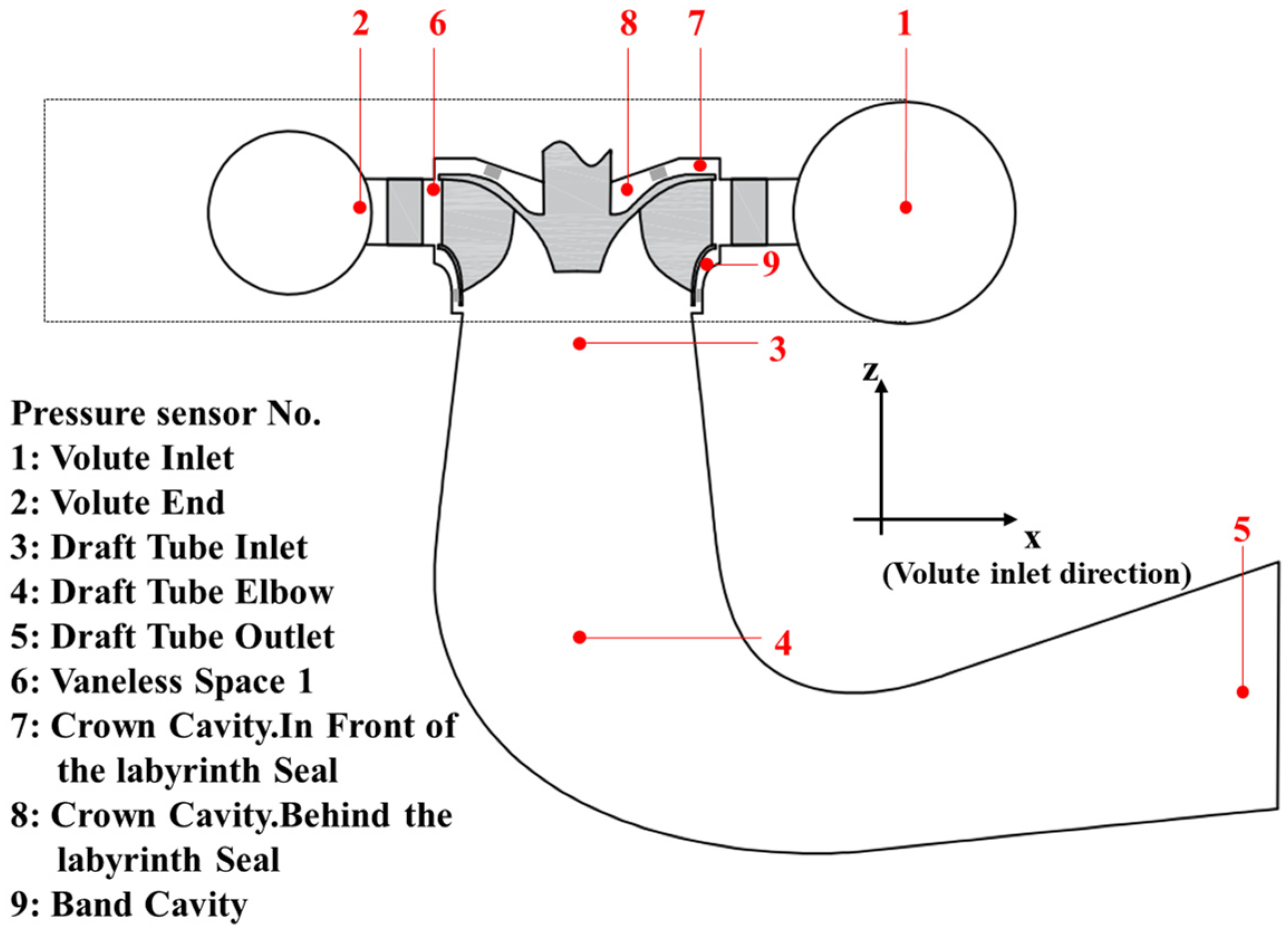
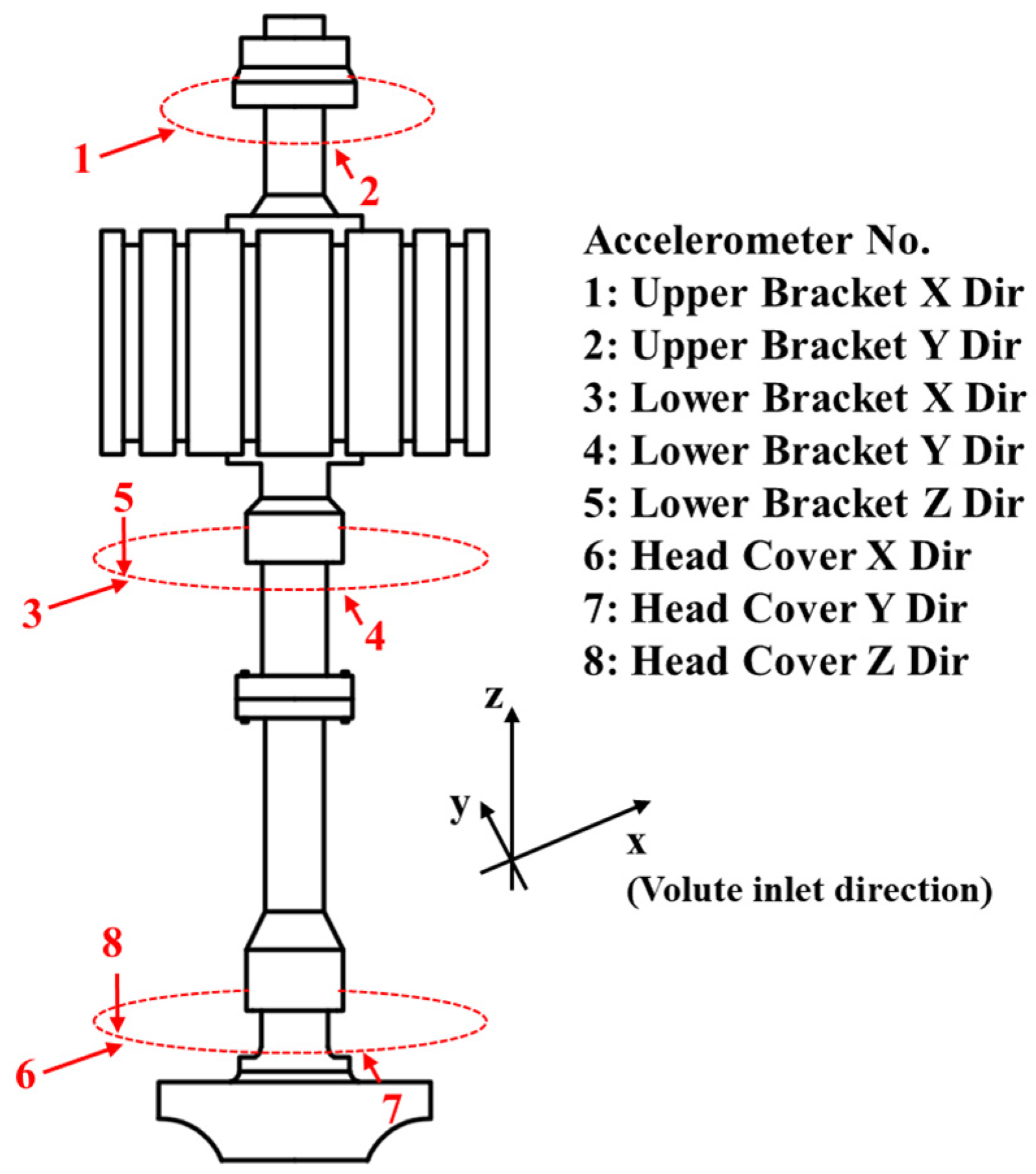

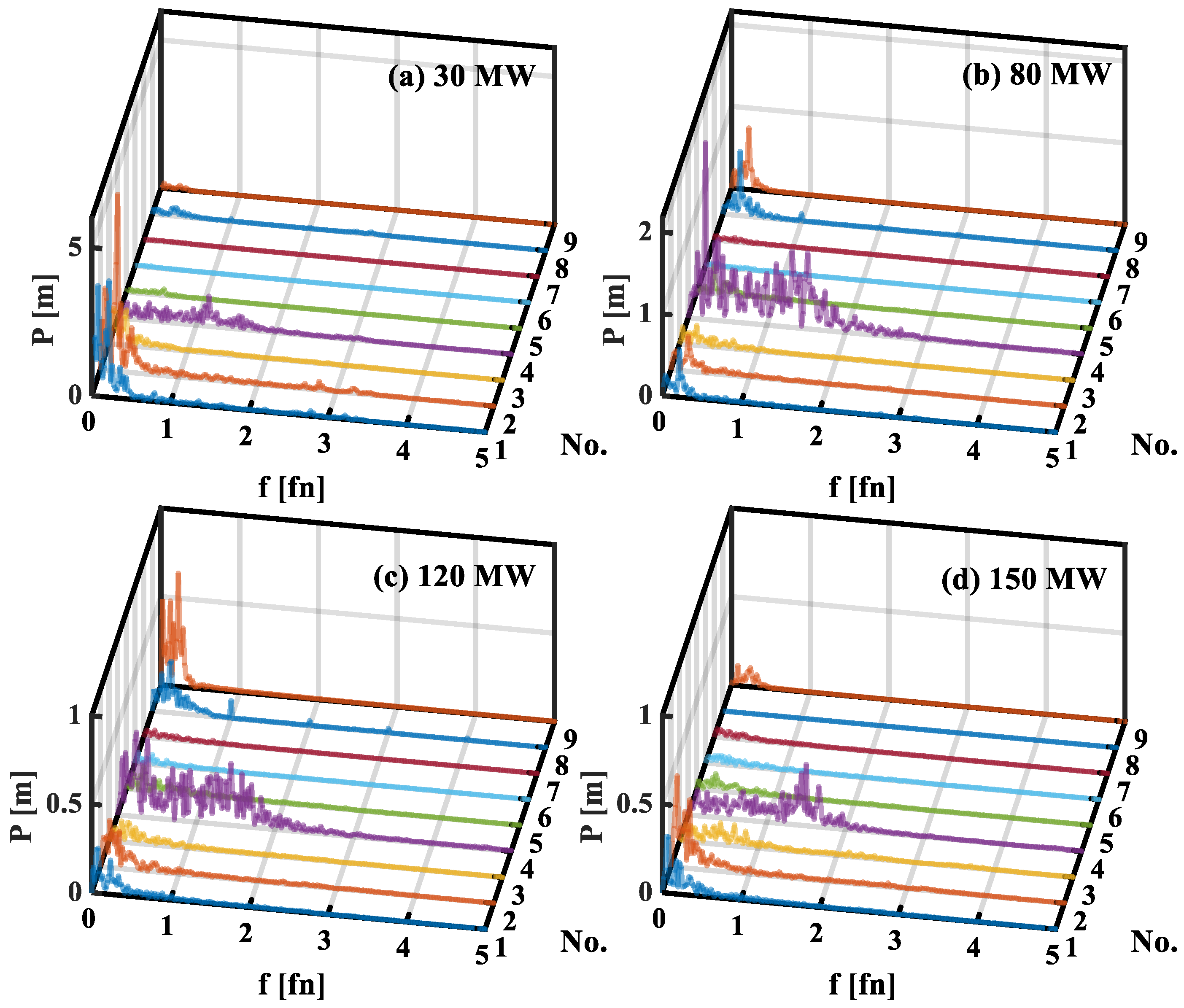
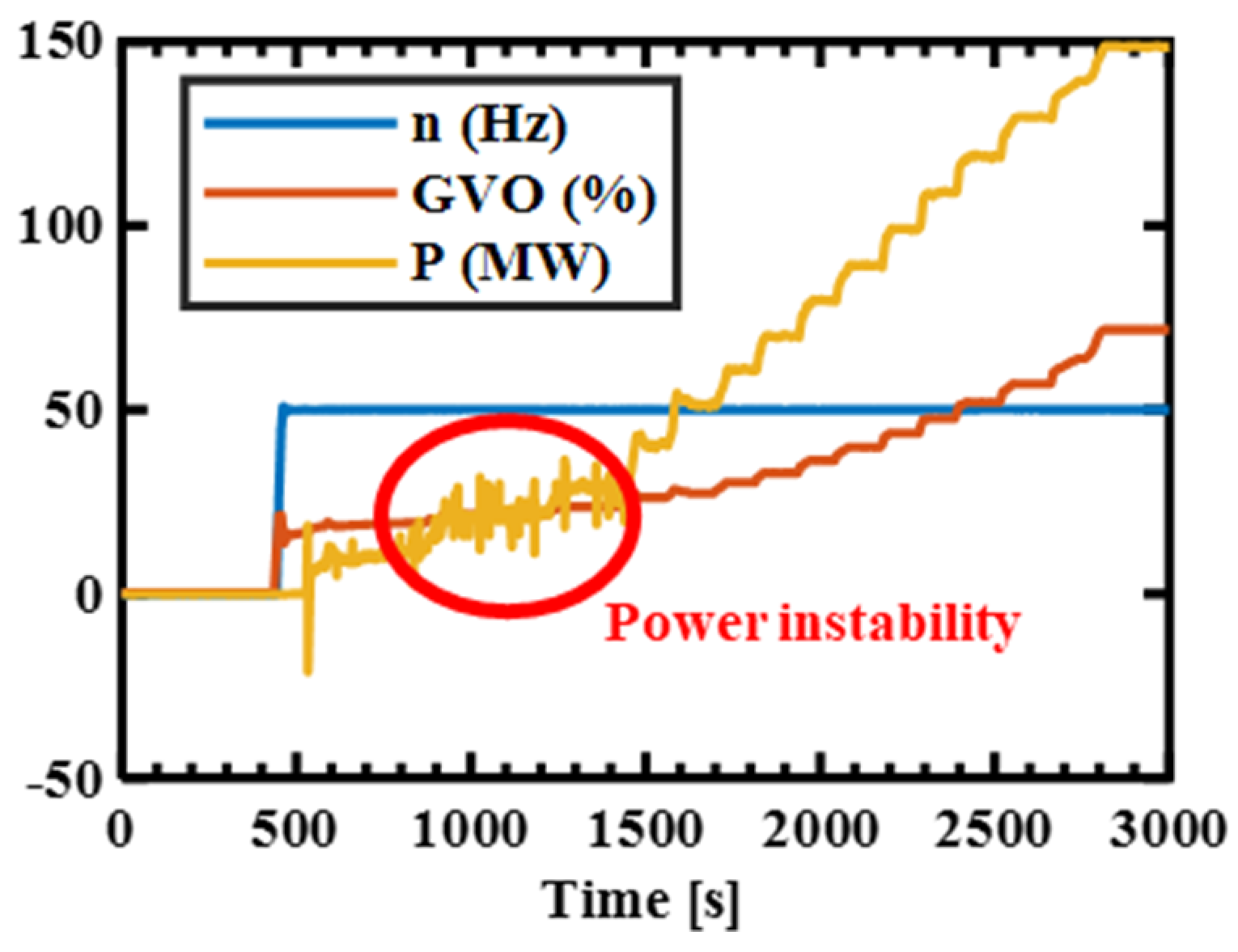
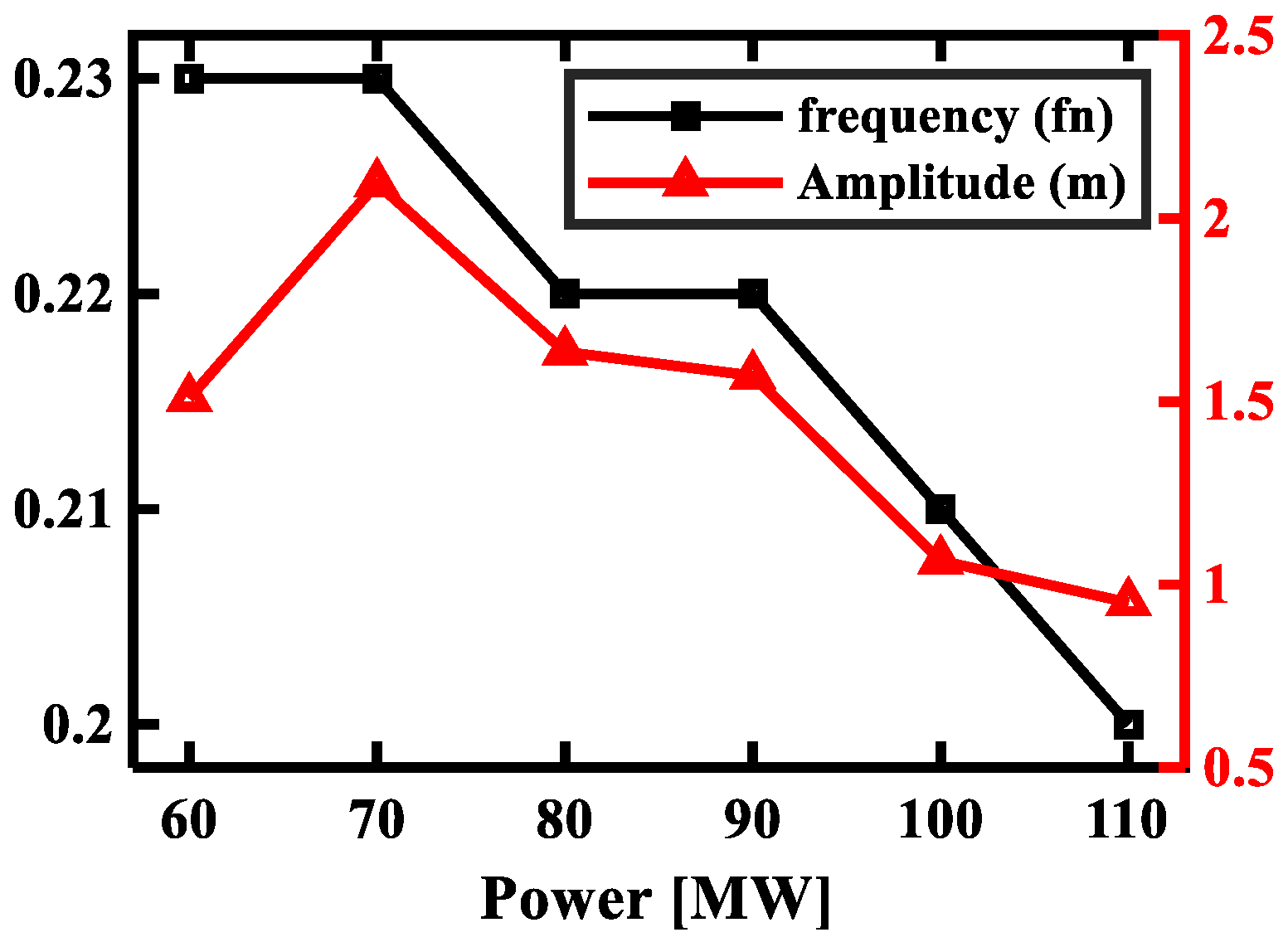
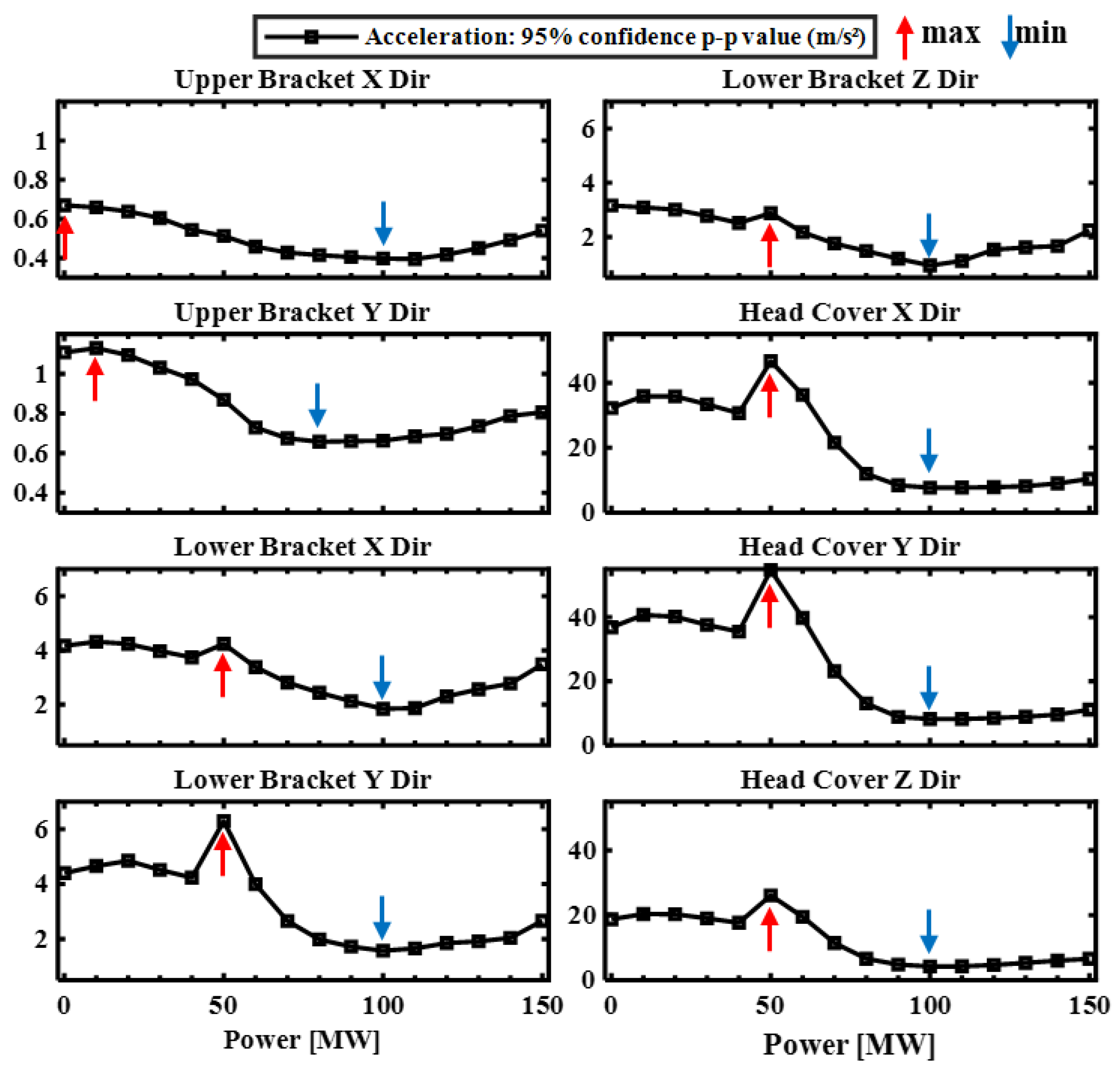

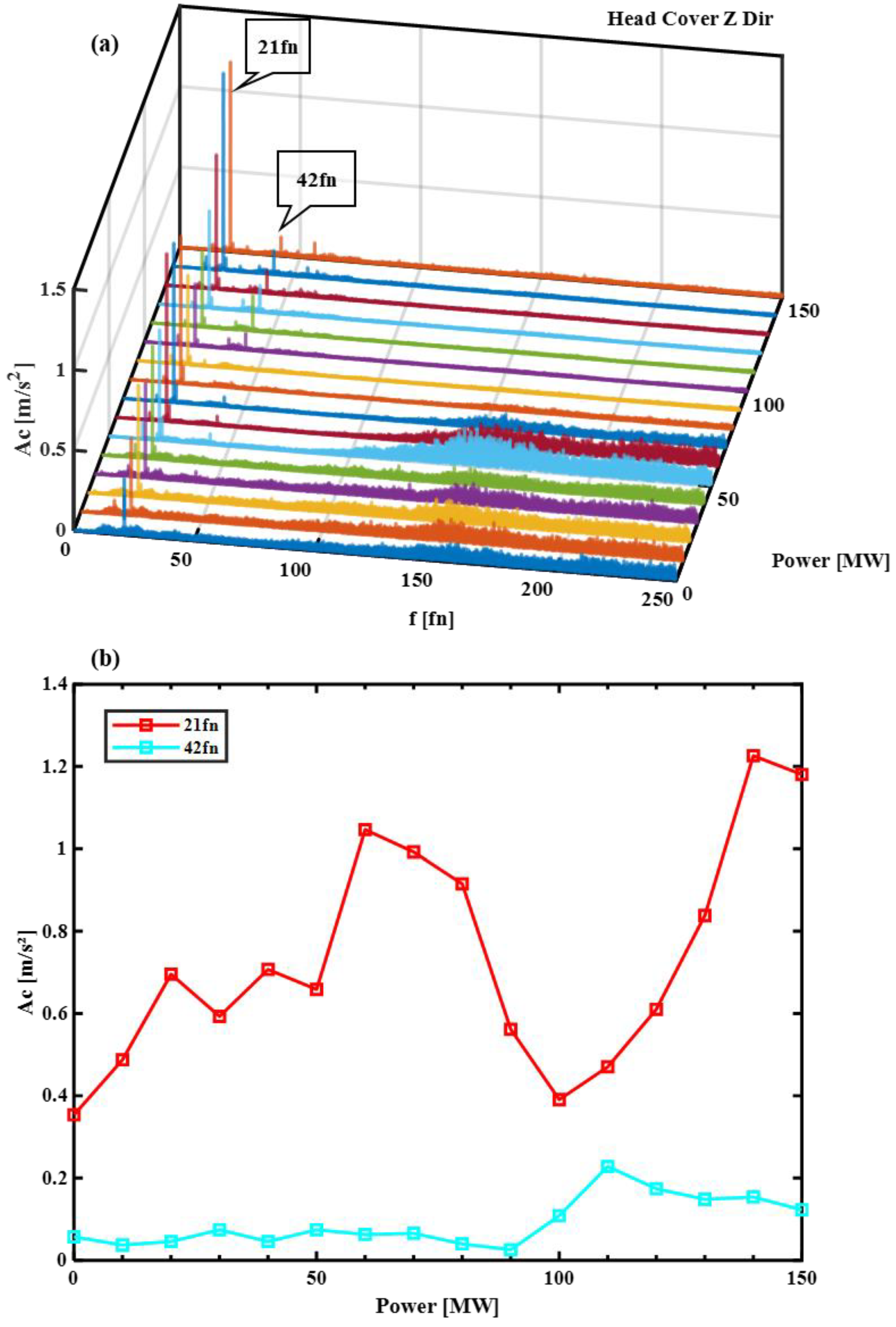
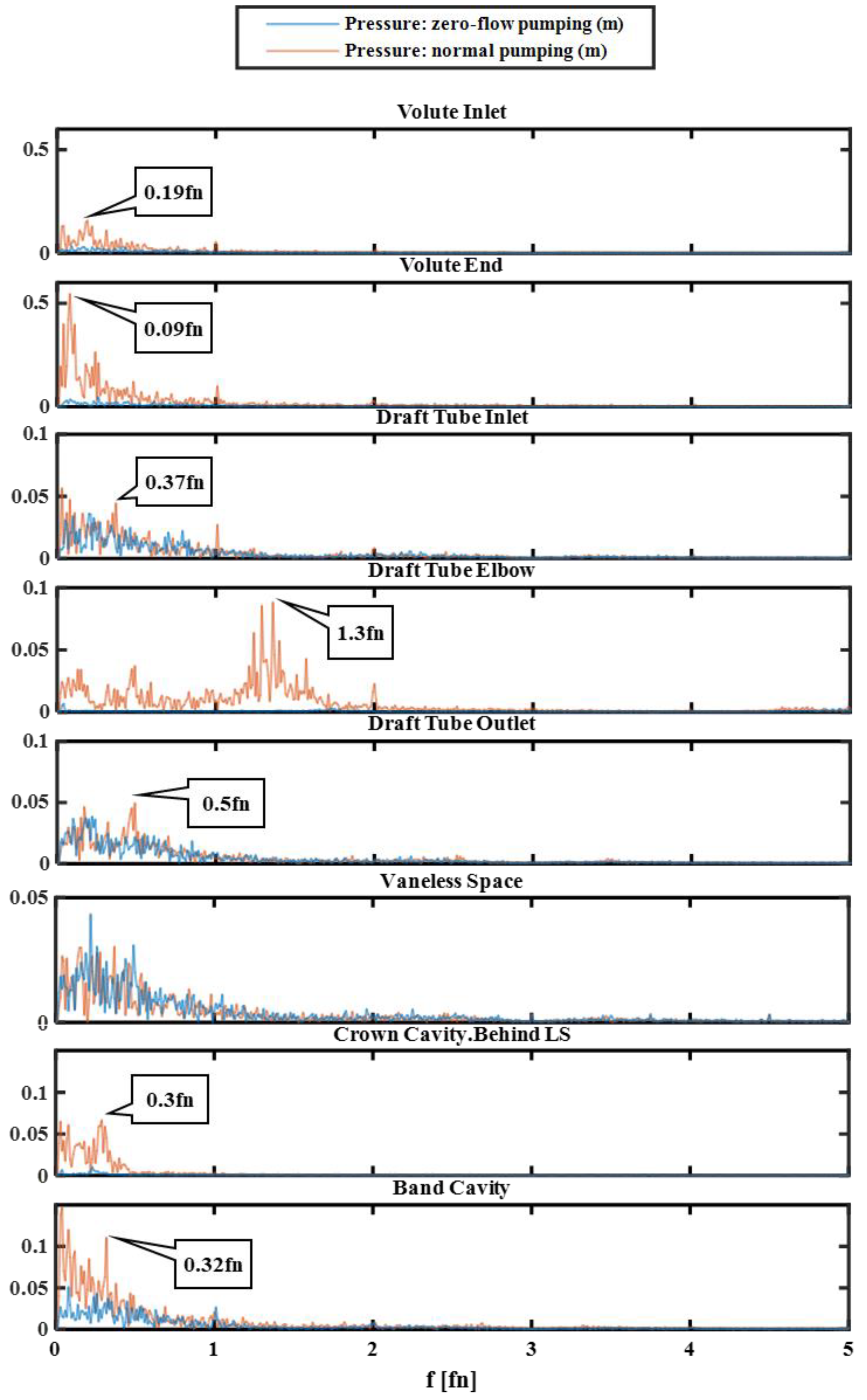
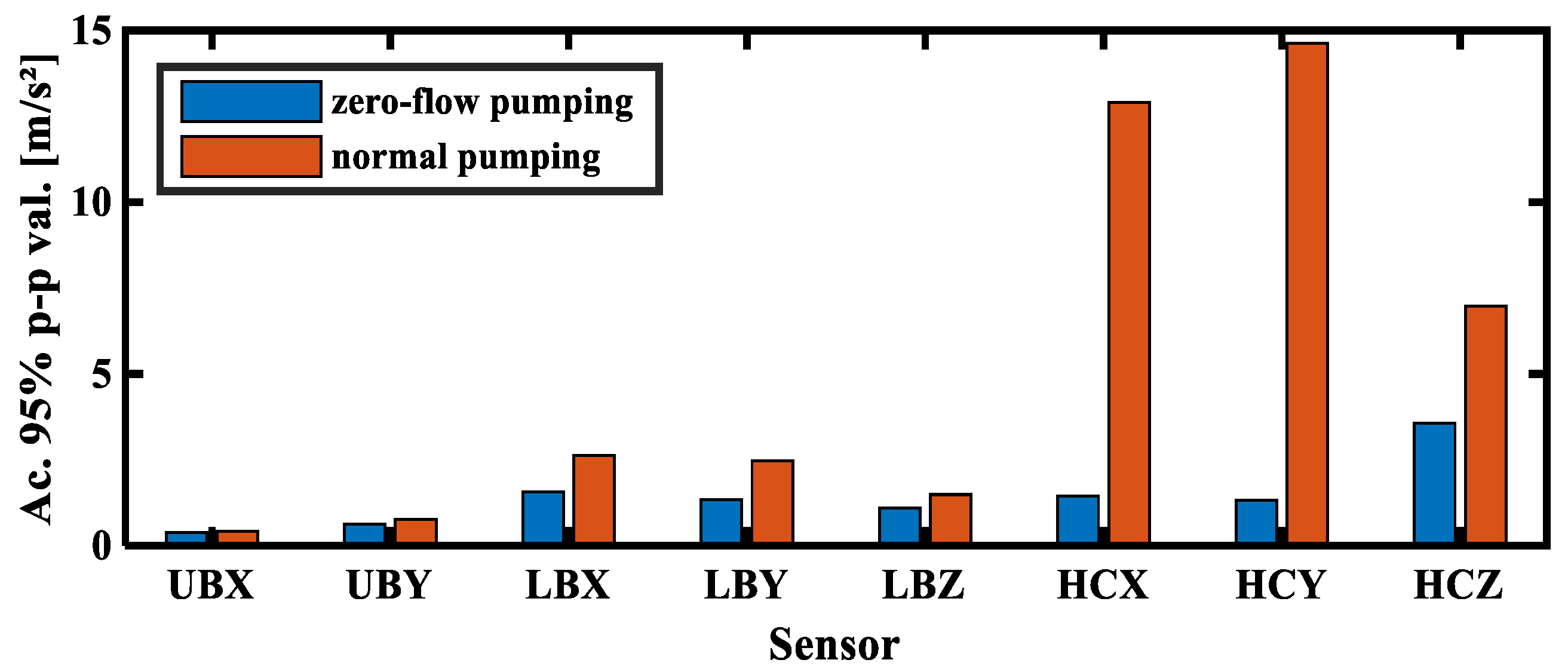

| Geometric parameters | Volute inlet diameter | ~4200 mm |
| Runner inlet diameter (D1) | ~5200 mm | |
| Runner outlet diameter (D2) | ~4100 mm | |
| Turbine mode | Specific speed (ns) | 228 |
| Rated head | 105.8 m | |
| Rated output power | 150 MW | |
| Rated speed | 200 rpm | |
| Rated discharge | 148.7 m3/s | |
| Pump mode | Design head | 126.7 m |
| Maximum discharge | 138 m3/s | |
| Maximum input power | 157.95 MW |
| Turbine mode | low load (10–40 MW) |
| medium load (70–90 MW) | |
| full load (100–130 MW) | |
| Pump mode | zero-flow |
| normal pumping |
| k | m | v | Mode Shape |
|---|---|---|---|
| 3 | 1 | 1 | 1 ND |
| 6 | 2 | 2 | 2 ND |
| 9 | 3 | 3 | 3 ND |
Disclaimer/Publisher’s Note: The statements, opinions and data contained in all publications are solely those of the individual author(s) and contributor(s) and not of MDPI and/or the editor(s). MDPI and/or the editor(s) disclaim responsibility for any injury to people or property resulting from any ideas, methods, instructions or products referred to in the content. |
© 2023 by the authors. Licensee MDPI, Basel, Switzerland. This article is an open access article distributed under the terms and conditions of the Creative Commons Attribution (CC BY) license (https://creativecommons.org/licenses/by/4.0/).
Share and Cite
Hu, H.; Xia, M.; Song, X.; Zhao, W.; Wang, W.; Wang, Z. A Field Investigation of Stability Characteristics of Pressure Fluctuation and Vibration in Prototype Pump Turbine at Multiple Working Points. Water 2023, 15, 3378. https://doi.org/10.3390/w15193378
Hu H, Xia M, Song X, Zhao W, Wang W, Wang Z. A Field Investigation of Stability Characteristics of Pressure Fluctuation and Vibration in Prototype Pump Turbine at Multiple Working Points. Water. 2023; 15(19):3378. https://doi.org/10.3390/w15193378
Chicago/Turabian StyleHu, Haiping, Ming Xia, Xianghui Song, Weiqiang Zhao, Wei Wang, and Zhengwei Wang. 2023. "A Field Investigation of Stability Characteristics of Pressure Fluctuation and Vibration in Prototype Pump Turbine at Multiple Working Points" Water 15, no. 19: 3378. https://doi.org/10.3390/w15193378
APA StyleHu, H., Xia, M., Song, X., Zhao, W., Wang, W., & Wang, Z. (2023). A Field Investigation of Stability Characteristics of Pressure Fluctuation and Vibration in Prototype Pump Turbine at Multiple Working Points. Water, 15(19), 3378. https://doi.org/10.3390/w15193378









